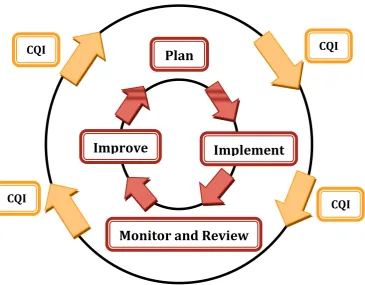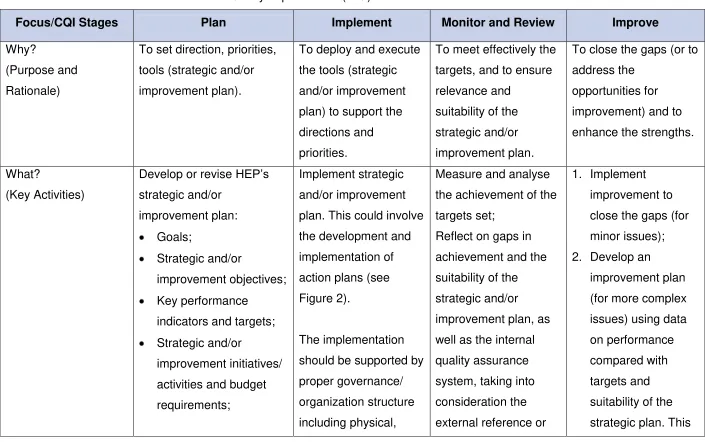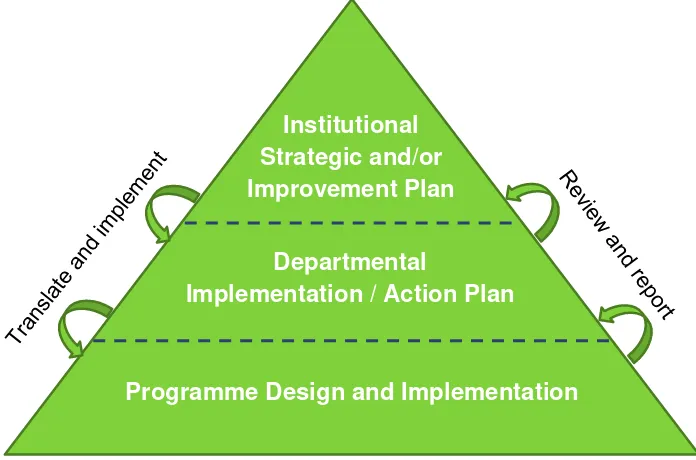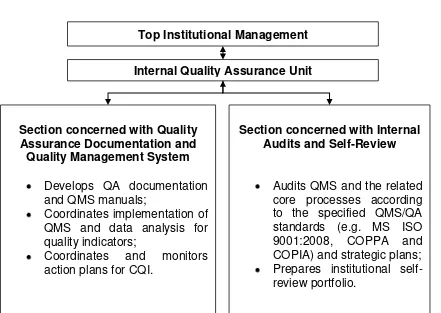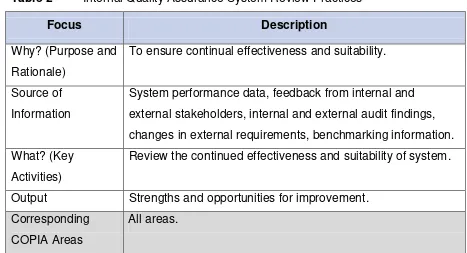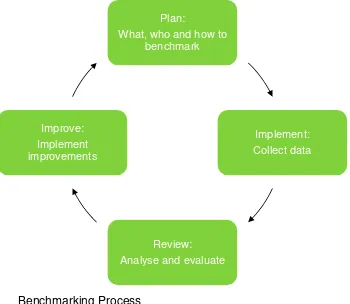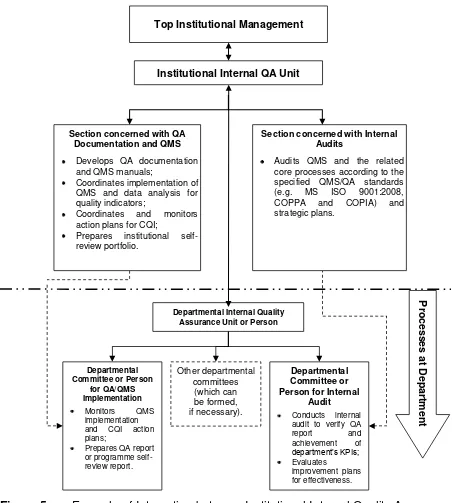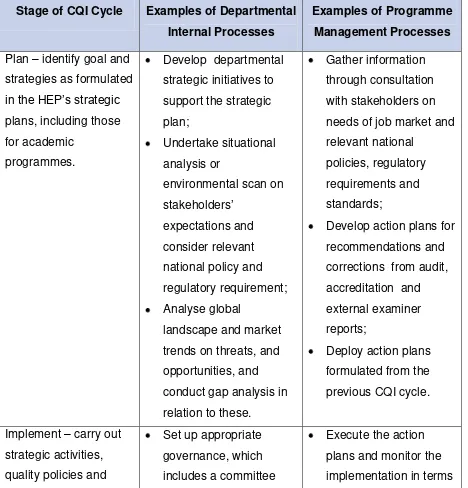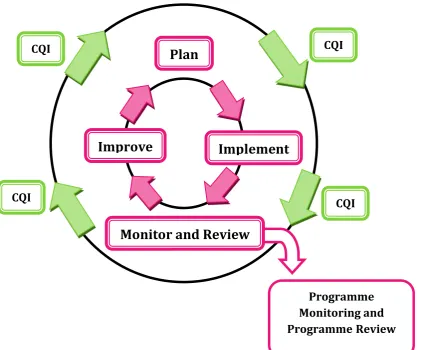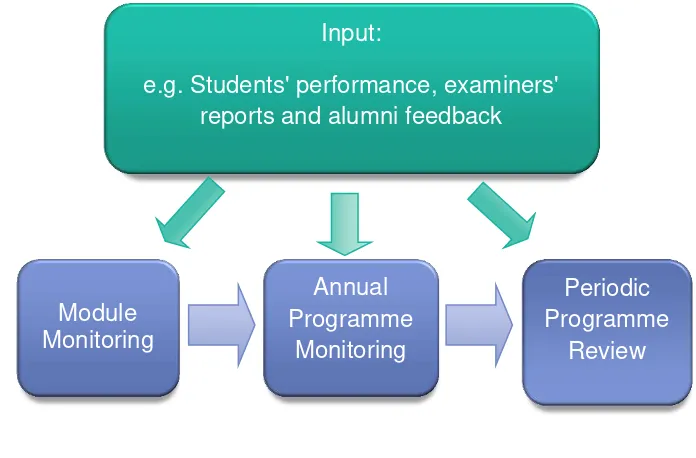i
GUIDELINES TO
GOOD PRACTICES:
Monitoring,
Reviewing
and
Continually Improving Institutional
Quality (GGP: MR and CIIQ)
2014
ii
GUIDELINES TO GOOD PRACTICES: MONITORING, REVIEWING AND
CONTINUALLY IMPROVING INSTITUTIONAL QUALITY
(GGP: MR and CIIQ)
Contents
GLOSSARY i
ABBREVIATION v
1.0 INTRODUCTION ... 1
1.1 Background To Quality Assurance In Higher Education ... 2
1.2 Quality Assurance Processes In Higher Education Providers ... 4
2.0 CONTINUAL QUALITY IMPROVEMENT... 6
2.1 Continual Quality Improvement Cycle ... 6
2.2 Institutional Level Continual Quality Improvement Practices ... 8
2.2.1 The Continual Quality Improvement Stages and Institutional Activities ... 14
2.2.2 Implementing Institutional Continual Quality Improvement ... 17
2.2.2.1 Roles and Responsibilities of an Institutional Internal Quality Assurance Unit ... 18
2.2.2.2 Review of Internal Quality Assurance System ... 20
2.2.3 Benchmarking as Continual Quality Improvement Tool ... 21
2.3 Departmental Level Quality Assurance Systems and Continual Quality Improvement Practices ... 22
2.3.1 Internal Quality Assurance Unit at The Departmental Level ... 23
2.3.2 Departmental Level Continual Quality Improvement Cycle ... 25
3.0 PROGRAMME MONITORING AND REVIEW ... 28
3.1 Introduction ... 28
3.2 Module Monitoring... 34
3.3 Annual Programme Monitoring ... 38
3.4 Periodic Programme Review ... 41
3.4.1 Programme Review and Self-Accrediting Heps... 42
3.4.2 Programme Review Schedule and Personnel ... 44
3.4.3 Criteria and Data for Programme Review ... 46
3.4.4 Stages in A Periodic Programme Review ... 51
3.4.5 Programme Self-Review Report and External Panel Report ... 53
4.0 CONCLUSION ... 56
iii GLOSSARY
1) Articulation Articulation is the process whereby a student or a group of students progresses from one qualification to the study of a higher qualification. Usually, this process involves credit transfer from the initial study to the new, higher level qualification.
2) Benchmarking Benchmarking is a tool to identify good practices and opportunities for improvement through comparison of performance and practices with those of purposefully selected HEPs.
3) Continual Quality Improvement Process
Continual quality improvement is a cyclical and continual process to bring about the enhancement of quality.
4) Departments Departments are functional units of an HEP. HEPs may use other terms for such functional units, including ‘school’, ‘unit’, and ‘centre’.
5) External Examiner An external examiner is an ‘expert’ in the discipline
that is external to the HEP. The external examiner is concerned with the moderation of the grading of
students’ work in a subject or subjects. This is most
often done to ensure that the grading complies with grading standards that are external to the HEP, and that there is consistency in the grading.
6) External Review Panel
iv
disciplines external to the programme but within the HEP, and could include representatives of bodies that
are external to the programme’s HEP, at national,
regional or international levels.
7) Improvement Plan An improvement plan outlines actions to achieve a goal. It does not necessarily arise from, or be connected to, the HEP’s strategic plan.
8) Institutional Audit An institutional audit is an external evaluation of an HEP to determine whether it is achieving its mission and goals, to identify strengths and areas of concern, and to enhance quality.
9) Key Performance Indicator
These are the main representations (usually numeric) of the state of, or outcome from, an education organisation or its programmes or processes. They are a set of tangible measures designed to provide public accountability and are subject to informed interpretation and judgment. Often included as key
performance indicators are admission and graduate data, research records, graduate employment rates,
cost per student, student/staff ratios, staff workloads, student relevance, class size, laboratory and other equipment, equity, libraries, information technology and other learning resources.
10) Moderation Moderation is the process of sharing expectations and understandings of standards among instructors in order to improve the consistency of their decisions about student learning and achievement.
v
‘module’ is used interchangeably with the terms
‘subject’, ‘unit’, or ‘course’ (MQA, 2008, 2009).
12) Module Monitoring Module monitoring is an on-going process of
collecting information to ensure all planned aspects of a module are meeting the aims and performance targets, and to ensure that the content aligns with the accepted standards or intended learning outcomes.
13) Pathway The term ‘pathway’ refers to the route taken by students to enter higher education. The pathway may
be termed ‘traditional’, whereby students enter higher
education as school leavers, or it may be termed ‘non
-traditional’ in that students have gained credit to enter higher education studies through previously-completed study
14) Progression Progression is the process of a student moving from one developmental year to the next, usually at the end of the academic year. To progress a student must
pass modules, or any specified core module, towards meeting programme requirements.
15) Programme Monitoring
Programme monitoring refers to a regular and systematic process of collection and analysis of information to track the quality of the programme against set plans, and to identify areas of risk as they arise. Monitoring allows adaptation of the program as needed to ensure that set programme objectives are achieved.
16) Programme Review (includes evaluation)
vi
report that reviews facts and includes self-reflections about the current status of an academic programme in
relation to its goals and to established markers of academic quality; (2) The external panel reviews the
report, undertakes a site visit to evaluate the status of the programme, and makes recommendations for improvement.
17) Quality Assurance Quality assurance comprises planned and systematic actions (policies, strategies, attitudes, procedures and activities) to provide adequate demonstration that quality is being achieved, maintained and enhanced, and meets the specified standards of teaching, scholarship and research as well as of the student learning experience. (MQA, 2008, 2009)
18) Quality Assurance System
This refers to a system within an education organisation that plans and performs a systematic review of an HEP or programme to determine that acceptable standards of education, scholarship and
infrastructure are being maintained and enhanced.
19) Quality Enhancement Quality enhancement refers to the steps taken to bring about continual improvement in quality. (MQA, 2008, 2009)
20) Quality Indicators Quality indicators are a set of established measures to determine the achievement of a prescribed outcome. HEPs may establish quality indicators that reflect their particular context and strategic directions.
21) Quality Management System (QMS)
vii quality objectives.
22) Strategic Plan The strategic plan outlines an HEP’s direction, priorities and goals that guide the allocation of
viii Abbreviations
COPIA Code of Practice for Institutional Audit
COPPA Code of Practice for Programme Accreditation CQI Continual Quality Improvement
GGP Guidelines to Good Practices HEP Higher Education Provider IQA Internal Quality Assurance
KPI Key Performance Indicator
LO Learning Outcome
MLO Module Learning Outcome
MQA Malaysian Qualifications Agency MQF Malaysian Qualifications Framework PEO Programme Educational Objective PLO Programme Learning Outcome PMR Programme Monitoring and Review
QA Quality Assurance
1
1.0 INTRODUCTION
The Guidelines to Good Practices: Monitoring, Reviewing and Continually Improving Institutional Quality (GGP: MR and CIIQ) is a document
developed to assist Higher Education Providers (HEPs) to: i) continually improve their quality, and ii) address the standards of two areas of the Code of Practice for Programme Accreditation (COPPA), the Code of Practice for Institutional Audit (COPIA), namely:
i. Programme Monitoring and Review, marked as Area 7, and ii. Continual Quality Improvement (CQI), marked as Area 9.
The document provides guidance for all involved in higher education, including: i) quality assurance agencies and their staff and associates, ii) academic and administrative staff in HEPs, and iii) Ministry of Education staff. The focus is on implementing appropriate CQI and programme monitoring and review. It is not intended to be prescriptive but rather to provide ideas for HEPs to adapt to their particular circumstances.
The document is part of a series of guidelines that are similarly designed to assist HEPs implement the practices and standards listed in COPPA and COPIA (the Codes of Practice). COPPA is concerned with the practices applied by HEPs in continual quality improvement and programme monitoring and review, whilst COPIA is primarily concerned with institutional
processes that are applied in continual quality improvement and programme monitoring and review. Both for programme accreditation and institutional
audit, the assessors’ concerns are primarily with the procedures and practices
adopted by the HEPs in the areas covered by the Codes, and whether these match the provisions of the Codes.
The structure of this GGP is as follows:
Section 2, CQI: the broad process of ensuring and improving quality in HEPs
Institutional level;
2
Section 3, Programme Monitoring and Review: within the HEP’s broader CQI context, the process of ensuring quality at the level of
curriculum
Module Level;
Programme Level.
1.1 BACKGROUND TO QUALITY ASSURANCE IN HIGHER
EDUCATION
Before discussing continual quality improvement (CQI) and programme monitoring and review as part of CQI, which are key elements of quality assurance in higher education, it is important to clarify the key role of higher education in the contemporary world, and the reason why the notions of ‘quality’ and ‘quality assurance’ are
integral to its provision.
In the highly competitive and globalised world of today, higher education has a significant role to play in the advancement of nations, including Malaysia. Nations need to educate greater numbers of people and to higher levels than in previous times so that they have the skills and understandings to enable the country to keep pace and to further develop its economic competitiveness. Furthermore, from social and cultural perspectives in relation to equity, it is well documented that individuals with higher education qualifications have greater life chances than those who do not, and so nations aim to educate a greater proportion of the population. Through processes of internationalisation, there has been large scale movement of people across countries as they pursue their educational objectives. All these factors have led to the rapid development of higher education globally.
Quality in higher education is a complex, contextualized and multi-dimensional concept (Vlasceanu et al., 2007, p.68; Tam, 2010). However, it can be said that quality is concerned with excellence, perfection, fitness for purpose, value for money and transformation to
3
Malaysian Qualifications Agency Code of Practice for Programme Accreditation (COPPA), as follows:
Increasingly, society demands greater accountability from HEPs. Needs are constantly changing because of the
advancements in science and technology, and the explosive growth in global knowledge, which are rapidly and widely disseminated. In facing these challenges, HEPs have little choice but to become dynamic learning organisations that need to continually and systematically review and monitor the various issues to meet the demands of the constantly changing environment (COPPA, 2008, pp. 30-31).
In the context of such a dynamic environment, HEPs must continually review the achievement of their strategic directions, as well as the suitability of these directions. Flowing from a broader institutional direction, programmes need to be monitored and reviewed systematically to ensure their suitability in relation to the strategic directions, changing conditions and educational best practice.
Given the broad and significant role of HEPs in today’s world,
many groups of people in society are higher education stakeholders
with an interest and strong investment in the operations and quality of higher education. Stakeholders need to be assured that the academic
programmes provided by HEPs are of value, that they reflect the institutional vision, mission and goals, and meet their stated aims and purpose and those of external professional bodies (Harvey & Stensaker, 2008). Such key stakeholders of the Malaysian higher education system, both local and international, include the following:
Government: provides funds and needs educated populace, forms higher education policies and directions;
Private providers: invest funds, often for business sustainability or betterment of the community as well as for enhancement of their
4
Higher Education Quality Assurance Agencies and professional bodies: ensure standards and the registration of HEPs’ qualifications;
Professional associations: have vested interest in the quality of the educational offerings;
Students and prospective students: learners who forgo other activities and perhaps income to undertake studies in HEPs;
Parents and sponsors of students: parties investing financially and personally in higher education;
Staff in HEPs: academic and administrative, whose livelihood is influenced by the quality of the HEP;
Industry/employers: bodies that employ graduates;
Alumni of the HEP: parties interested in the reputation of the awarding HEP;
Community in general: citizens who are aware of the social impact of HEPs and of their graduates on the community.
Active involvement of staff, students and other stakeholders should be an integral part of quality assurance processes. Such participation is important to obtain as wide as possible a perspective as to what constitutes quality. As explained previously, stakeholders have
vested interests in sustaining the HEP’s quality, at the institutional,
departmental and programme level.
1.2 QUALITY ASSURANCE PROCESSES IN HEPs
The mechanism to effectively implement CQI in a HEP is
through the HEP’s internal quality assurance (IQA) system. The IQA system addresses the implementation of the HEP’s directions and achievement of its goals in the changing world. The more specific
aspects of quality and its assurance are demonstrated through the
5
operations 1 . These are described in the Code of Practice for Institutional Audit (COPIA), the Code of Practice for Programme
Accreditation (COPPA) and the disciplinary Programme Standards. As part of such an on-going process, all HEPs have processes
to ensure the quality of programme design in new programme approval, and existing programme monitoring and review. Once programmes have been established and are operational, programme monitoring and review have a central role in ensuring quality. In fact, the overall aim of programme monitoring and review is to ensure the validity and relevance of programmes; that is, the quality.
It is important to point out that these processes may be interpreted differently across HEPs, which reflect a range of objectives and practices. However, some general definitions for the processes involved are outlined in the Glossary.
1 The nine areas of evaluation in the current COPIA (2009) and COPPA (2008) are: 1) Vision, Mission,
6
2.0 CONTINUAL QUALITY IMPROVEMENT
The broad process through which HEPs monitor and improve their quality is called Continual Quality Improvement (CQI).
2.1 CONTINUAL QUALITY IMPROVEMENT CYCLE
Maintaining and improving quality in a HEP is a cyclical and continual process, with one step leading to the next in an on-going mode. The stages can be seen in Figure 1, which outlines a commonly used and accepted model based on the Plan-Do-Check-Act (PDCA Cycle) also known as Deming Cycle (1950).
.
Figure 1 Continual Quality Improvement Cycle2
The practice of CQI is significant in the achievement of the HEP’s vision, mission, educational goals and learning outcomes. It is also integral to the continual
effectiveness and suitability of the HEP’s internal quality assurance (IQA) system,
2Nomenclature for the stages may vary, e.g. they may be named:’Plan’;‘Do’;‘Check’;‘Act’.
Plan
CQI
Improve
Implement
CQI CQI
Monitor and Review
7
and its academic programmes. A common approach to CQI involves the following
stages. The HEP’s IQA system is the supporting mechanism through which these
stages are enacted:
i. Plan: Develop or revise the HEP’s strategic and/or improvement plan in
relation to the desired improvement;
ii. Implement: Deploy the strategic and/or improvement plan3;
iii. Monitor and Review: Measure and analyse the achievement of the targets set; reflect on gaps in achievement and on the suitability of the strategic and/or improvement plan;
iv. Improve: Implement improvement or develop an improvement plan based on performance in relation to targets and the suitability of the strategic and/or improvement plan.
Specifically, this GGP: MR and CIIQ is concerned with the overall CQI stages as they apply at the institutional level and as they impact on departmental level operations. Such an overall perspective is addressed in Section 2.2 and 2.3 of this document. Within the departmental level operations, Section 3 of this document addresses programme-level monitoring and review.
In more detail:
CQI at the institutional level is a process of regularly reviewing and updating the HEP’s activities to assure and improve quality through applying the CQI
stages of ‘plan’, ‘implement’, ‘monitor and review’, and ‘improve’. At the institutional level, CQI focuses on the effectiveness of the strategic and/or improvement plan, and of the HEP’s internal quality assurance system in terms of administrative structure, leadership and governance, planning, and monitoring and review mechanisms;
At the departmental level, this GGP: MR and CIIQ focuses on the effective implementation of the strategic and/or improvement plan, and the alignment of
the department’s academic programmes to the plan. It is also concerned with supporting the operation of the HEP’s IQA system. At the departmental level,
3 A strategic plan normally contains top-down initiatives. However, improvement initiatives may arise
8
CQI considers administrative structure, leadership and governance, planning, and monitoring and review mechanisms;
At the programme level, this GGP: MR and CIIQ refers to the process of regularly reviewing the tools (such as surveys and data collection and their analysis) and activities (for example, improvements in curriculum) used for programme monitoring and review (PMR).
2.2 INSTITUTIONAL LEVEL CONTINUAL QUALITY IMPROVEMENT
PRACTICES
Continual quality improvement at the institutional level is a systematic and structured mechanism enabling the HEP to achieve its vision, mission and educational goals, as well as to improve continually its internal quality assurance system (IQA). This process usually
emanates from the HEP’s strategic plan and involves the whole of the HEP. However, it may be initiated through more specific improvement plans that involve certain processes.
Institutional-level CQI generally covers the four stages of the CQI cycle: ‘plan’, ‘implement’, ‘monitor and review’; and ‘improve’. However, these stages may not always occur sequentially. For
instance, unexpected external and internal environmental events, such as governmental policy change and change of the HEP’s direction,
may mean that the ‘plan’ stage needs to be revisited. In such a situation, the strategic plan and/or improvement plan would be adjusted so that the HEP can cope under the changed circumstances.
The purpose and rationale (the ‘why’), the key activities (the
9
Table 1 Institutional Level Continual Quality Improvement (CQI) Practices
Focus/CQI Stages Plan Implement Monitor and Review Improve
Why?
(Purpose and Rationale)
To set direction, priorities, tools (strategic and/or improvement plan).
To deploy and execute the tools (strategic and/or improvement plan) to support the directions and priorities.
To meet effectively the targets, and to ensure relevance and
Develop or revise HEP’s strategic and/or plan. This could involve the development and implementation of action plans (see Figure 2).
The implementation should be supported by
proper governance/ organization structure including physical,
Measure and analyse the achievement of the targets set;
10
Focus/CQI Stages Plan Implement Monitor and Review Improve
Corresponding/ consists of internal and external review, which
11
Focus/CQI Stages Plan Implement Monitor and Review Improve
trends (such as job
market trend and industry needs/expectation);
• Feedback from third party evaluation, such as, institutional audit, service delivery audit or quality management system audit;
• Benchmarking report;
• Feedback from internal and external
stakeholders, including students;
• Availability of resources;
• Improvement plans based on achievement of the implementation of existing strategies or plans.
12
Focus/CQI Stages Plan Implement Monitor and Review Improve
Output Strategic and/or
improvement plan, (new or improved) supported by covers other eight (8) areas)
4 The various stages of the CQI cycle are linked to the relevant COPIA areas for evaluation. The corresponding COPIA areas for the planning stage
are: Area 1, Vision, Mission, Educational Goals and Learning Outcomes, and Area 8, Leadership, Governance and Administration. The corresponding COPIA
areas for the implementation stage are: Area 2, Curriculum Design and Delivery, Area 3, Assessment of Students, Area 4, Student Selection and Support
Services, Area 5, Academic Staff, and Area 6, Educational Resources. The corresponding COPIA areas for the monitoring and review stage are: Area 1,
Vision, Mission, Educational Goals and Learning Outcomes, and Area 7, Programme Monitoring and Review. Finally, the corresponding COPIA area for the
13
Focus/CQI Stages Plan Implement Monitor and Review Improve
14
2.2.1 THE CONTINUAL QUALITY IMPROVEMENT STAGES AND
INSTITUTIONAL ACTIVITIES
As seen in Table 1, at the institutional level, the purpose of the planning stage is to set the direction, the priorities and
the relevant tools for achieving the direction. It focuses on formulating the institutional strategic and/or improvement plans, which consist of goals, strategic or improvement objectives, key performance indicators and targets, as well as strategic or improvement initiatives/activities, and budget requirements. The strategic and/or improvement plan should be supported by the
HEP’s internal quality assurance system. For example, one of
the educational goals of an HEP may be to produce graduates with global perspectives. To support the achievement of this educational goal, the governance, curriculum, teaching and learning activities, assessment, support services, academic staff and educational resources as well as the programme monitoring and review practices should be aligned accordingly. (These are the nine areas of quality assurance of the Code of Practice for Institutional Audit: COPIA.)
The information for the planning stage is usually collected
from analysing the situation or scanning the environment. The information may emanate from the following dimensions:
Government policies and directions on higher education;
Changes in code of practices and programme standards;
Global and national development in higher education;
Global and local market trends (such as job market trends and industry needs/expectations);
Feedback from third party evaluation, such as, institutional audit, service delivery audit or quality management system audit;
15
Feedback from internal and external stakeholders, including students;
Availability of resources;
Improvement plans based on achievement of the implementation of existing strategies or plans.
The output of the planning stage is a new or improved strategic and/or improvement plan, supported by the HEP’s internal quality assurance system. The output of the planning
stage triggers the next stage, which is the implementation stage. The focus of the implementation stage is to deploy and execute the strategic and/or improvement plan to support the directions and priorities. As mentioned earlier, the strategic and/or improvement plans should be communicated to the relevant committees, departments and individuals for their effective implementation at the implementation stage (refer to Figure 2). In addition, a more detailed implementation/action plan could be developed and implemented at this stage.
16
Figure 2 Implementing and Reviewing Institutional Strategic and/or Improvement Plan
The purpose of the monitoring and review stage is to understand whether the HEP has effectively met the targets of
the strategic and/or improvement plan, as well as to ensure the relevance and suitability of the plan. Hence, at this stage, the
HEP measures and analyses the achievement of the targets set (refer to Figure 2). The HEP also reflects on gaps in achievement. In addition, the HEP reflects on the relevance and suitability of the strategic or improvement plan, as well as the internal quality assurance system, taking into consideration the external reference or benchmark.
‘Monitoring’ refers to on-going developmental or formative activities to ensure the effective implementation of the strategic and/or improvement plan to achieve the goals. ‘Review’ refers to periodic formative and summative activities to ensure the continual effectiveness and suitability of the strategic and/or improvement plan. Review normally consists of internal and external review. Internal review is conducted by the committee, department or individual responsible for the strategic and/or improvement plan implementation, as well as the internal quality
Programme Design and Implementation Institutional
Strategic and/or Improvement Plan
Departmental
17
assurance system. Inputs to internal review normally involve performance data, feedback from internal and external
stakeholders, internal and external audit findings, changes in external requirements, and benchmark information. External
review is normally conducted by external agencies, such as service delivery audit or quality management system audit conducted by a certification body, as well as external reporting. The output of the monitoring and review stage is statements of
the HEP’s strengths and opportunities for improvement in regard to the strategic and/or improvement plan.
The purpose of the improvement stage is to ‘close the gaps’ by addressing the opportunities for improvement and to
enhance the strengths to ensure the HEP’s sustainability. At this stage, improvement is implemented for minor issues and an improvement plan is developed for more complex issues. Performance data is used in relation to targets and the suitability of the strategic plan. This step could lead to updating the strategic and/or improvement plan, as well as the internal quality assurance system. The improvement achieved and the improvement plan developed provides input for the next cycle of
planning.
2.2.2 IMPLEMENTATION OF INSTITUTIONAL CONTINUAL
QUALITY IMPROVEMENT
In summary, to apply continual quality improvement effectively at the institutional level, the following entity and related mechanisms are important.
An institutional internal quality assurance (IQA) unit that administers and manages the CQI process (this is a COPIA requirement), as discussed in Section 2.2.2.1;
A system to monitor and review the HEP’s strategic and/or
18
recommendations and to record the achievements towards continual improvement;
A system to regularly review and improve the HEP’s IQA system (which is directed at ensuring continual improvement
towards meeting the HEP’s strategic and/or improvement
plan, as required in COPIA). This is discussed in Section 2.2.2.2;
A culture in the HEP that values and appreciates the importance of quality and CQI.
The following subsections discuss the roles and responsibilities of the IQA unit in an HEP, and CQI of the IQA system itself through the process of review.
2.2.2.1 ROLES AND RESPONSIBILITIES OF AN
INSTITUTIONAL INTERNAL QUALITY
ASSURANCE UNIT
The HEP’s IQA unit5 has the responsibility and authority to carry out the institutional quality assurance agenda, which includes establishing,
reviewing and improving the HEP’s IQA system. To
ensure independence of authority, the IQA unit should be given prominent status in the HEP, as stated in COPIA. The information about the quality agenda flows upwards as well as downwards from the HEP’s management. Sufficient resources, including human, financial and physical, should be provided to the IQA unit.
The IQA unit may be structured in such a way that enables it to carry out the two important functions of:
5
19
a) Establishing and improving the IQA system, including CQI activities;
b) Reviewing the IQA system, including conducting internal audit and self-review.
While an IQA unit may be effectively structured in a range of ways, one example as seen in Figure 3 demonstrates the inclusion of both the functions outlined.
Figure 3 Example of Functional Structure of Institutional Internal Quality Assurance Unit
Top Institutional Management
Internal Quality Assurance Unit
Section concerned with Quality Assurance Documentation and Quality Management System
Develops QA documentation and QMS manuals;
Coordinates implementation of QMS and data analysis for quality indicators;
Coordinates and monitors action plans for CQI.
Section concerned with Internal Audits and Self-Review
20
2.2.2.2 REVIEW OF THE INTERNAL QUALITY
ASSURANCE SYSTEM
Regular review of the HEP’s internal quality assurance (IQA) system is required to assist the HEP to keep abreast of best practices and maintain relevant standards. The review interval can be decided by the HEP according to its needs. The review is normally coordinated by the HEP’s IQA unit with the involvement of relevant stakeholders. Input to the review normally includes system performance data including feedback from internal and external stakeholders, internal and external audit findings, changes in external requirements, and benchmarking information. The output of the review, which may include the strengths and opportunities for improvement, becomes the input for improving the IQA system. Table 2 exemplifies the process of reviewing the IQA system.
Table 2 Internal Quality Assurance System Review Practices
Focus Description
Why? (Purpose and Rationale)
To ensure continual effectiveness and suitability.
Source of Information
System performance data, feedback from internal and external stakeholders, internal and external audit findings, changes in external requirements, benchmarking information.
What? (Key Activities)
Review the continued effectiveness and suitability of system.
Output Strengths and opportunities for improvement.
Corresponding COPIA Areas
21
2.2.3 BENCHMARKING AS A TOOL FOR CONTINUAL QUALITY
IMPROVEMENT6
Benchmarking may be used as a tool for identifying
opportunities for improvement and becoming aware of good practices that can be applied or adapted to improve the HEP’s quality. The HEP’s goals or performance and practices are compared with those of selected HEPs, which are benchmarked against. The output of the process, which normally includes the strengths and opportunities for improvement, will become the input for improving the institutional goals, strategic plan, as well as the quality assurance system.
The benchmarking process normally involves four stages, as summarised in the following Figure 4.
Figure 4 Benchmarking Process
6 The explanation provided in this section refers to a general benchmarking technique that applies to all
nine areas of COPIA/COPPA and may be implemented across all types of HEPs. Please note that there are a variety of other benchmarking techniques available.
Plan:
What, who and how to benchmark
Implement: Collect data
Review: Analyse and evaluate Improve:
22
The key activities at the four stages are as follows: 1. Planning stage:
Areas are identified for benchmarking, what to benchmark is defined, benchmarking partners are selected, and agreement
is reached on the benchmarking approach; 2. Implementation stage:
Data are collected according to the agreed plan, which could
be performance or good practice-based; 3. Review stage:
Data collected are analysed to identify comparative strengths and opportunities for improvement. A report (informal or formal) that outlines the findings and recommendations for improvements is prepared and communicated;
4. Improvement stage:
The recommended improvements are implemented. The output of this benchmarking cycle may become the input of the next benchmarking cycle.
2.3 DEPARTMENTAL LEVEL CONTINUAL QUALITY IMPROVEMENT
PRACTICES
The implementation of the institutional strategic and/or improvement plan needs to flow through to the departmental level. Planned activities and related Key Performance Indicators (KPIs) need to be communicated to the relevant parties to ensure successful implementation. This stage also provides feedback from the
departmental level about challenges and achievements that occur in the implementation, and consequent readjustments to the strategic and/or improvement plan can be made.
23
2.3.1 INTERNAL QUALITY ASSURANCE UNIT AT THE
DEPARTMENTAL7 LEVEL
In maintaining and extending educational quality in the
department, it is useful if there is a particular unit or person who has the responsibility for advancing support for the HEP’s policies, procedures and mechanisms for regular review and the updating of the HEP’s strategic plans and stated purpose. The unit or person should play a prominent role in departmental policy processes and in managing quality activities, including CQI, within the department. The unit or person should work with the institutional IQA unit to ensure effective activities. An example of such interaction can be seen in Figure 5.
24
Figure 5 Example of Interaction between Institutional Internal Quality Assurance Unit and Departmental Internal Quality Assurance Unit or Person
It is useful if the departmental IQA structure reflects that of the institutional IQA unit (as discussed in Section 2.2.2.1), so as to facilitate a seamless and integrated interaction. This is seen in the example provided in Figure 5. However, it is important that the unit operates with some level of independence to ensure objectivity in outcomes.
Top Institutional Management
Institutional Internal QA Unit
Section concerned with QA Documentation and QMS
Develops QA documentation and QMS manuals;
Coordinates implementation of QMS and data analysis for quality indicators;
Coordinates and monitors action plans for CQI;
Prepares institutional self-review portfolio.
Section concerned with Internal Audits
Audits QMS and the related core processes according to the specified QMS/QA standards (e.g. MS ISO 9001:2008,
COPPA and COPIA) and
strategic plans.
Departmental Internal Quality Assurance Unit or Person
25
2.3.2 DEPARTMENTAL LEVEL CONTINUAL QUALITY
IMPROVEMENT CYCLE
Table 3 elaborates on the four stages of the Continual Quality
Improvement (CQI) cycle at the departmental level and their coherence with the basic standards in COPPA and COPIA.
Table 3 Departmental Level Continual Quality Improvement Cycle
Stage of CQI Cycle Examples of Departmental
Internal Processes
Examples of Programme
Management Processes
Plan – identify goal and strategies as formulated
in the HEP’s strategic
plans, including those for academic
programmes.
Develop departmental strategic initiatives to support the strategic plan;
Undertake situational analysis or trends on threats, and opportunities, and conduct gap analysis in relation to these.
Gather information through consultation with stakeholders on needs of job market and relevant national
policies, regulatory requirements and standards;
26
Stage of CQI Cycle Examples of Departmental
Internal Processes
structure to support the implementation, with
stipulated by the plans;
Perform verification, validation and real-time data analysis and make
necessary adjustment and alignment to the plans for continuous or continual improvement of the process, guided by the QA and QMS
Review – measure and reflect the achievement/ performance.
Review the alignment of the strategic initiatives to
the HEP’s purpose (vision, mission and institutional objectives) as well as to national policies and master plans, if relevant;
Review strategic initiatives through such as internal audits
27
Stage of CQI Cycle Examples of Departmental
Internal Processes
Examples of Programme
Management Processes
and surveys. Assess compliance with
certification/
accreditation standards as stipulated by the external QA parties,
Formulate action plans to conform to the HEP’s
Formulate action plans to ensure conformance
The institutional level CQI activities are supported by and feed into the departmental CQI activities. Departmental QA activities include review of administrative structure, leadership and governance, planning, monitoring and review, as well as curriculum monitoring and review (this is the focus of Section 3 of this GGP: MR and CIIQ). The
‘plan’ and ‘implement’ stages of CQI at the programme level have been discussed in the MQA Guidelines to Good Practices: Curriculum Design and Delivery and the
28
Plan
CQI
Improve
Implement
CQI CQI
Monitor and Review
Programme Monitoring and ProgrammeReview
CQI
3.0 PROGRAMME MONITORING AND REVIEW
3.1 INTRODUCTION
Programme monitoring and review does not occur in isolation but is an aspect of continual quality improvement that takes place at the level of curriculum. Figure 6 provides a visual representation of the relationship of programme monitoring and review to the larger CQI process and activities.
29
In essence, programme monitoring and review processes for modules and programmes are self-reflective, self-critical processes
concerning the performance and effectiveness of the modules and programmes. These processes are developmental and formative, and
lead to actions for improvement. Succinctly, while both programme monitoring and programme review has results, the outcome of monitoring is the maintenance of academic quality. The outcome of review, on the other hand, can lead to large scale changes to the programme. The major differences between programme monitoring and programme review are the scope and the frequency.
Programme monitoring and review are linked processes, as seen in Figure 7.
Figure 7 Process of Monitoring and Review
Figure 7 shows that various sources of information are collected for module monitoring. Examples include examiner and benchmarking reports, students’ performance; students’ evaluation of teaching, alumni and industry feedback, and changes in policy. These are
analyzed to identify the strengths and weaknesses of the module and the areas requiring change and improvement. The monitoring is undertaken by the module coordinator in conjunction with the module
Input:
e.g. Students' performance, examiners' reports and alumni feedback
Module Monitoring
Annual Programme
Monitoring
Periodic Programme
30
team. The results of the monitoring are fed into the annual programme monitoring process, and eventually, into the periodic programme
review.
Annual programme monitoring focuses on the maintenance of
the quality of the students’ educational experience and improvement of
the delivery system. As explained in Section 3.4 the periodic programme review is undertaken less frequently than the module and programme monitoring, and is comprehensive in scope, aims and processes.
31
Table 4 Overview of Module Monitoring, Programme Monitoring and Periodic Programme Review
Focus Module monitoring Programme Monitoring Periodic Programme Review8
When? Every semester where the subject operates.
Normally is undertaken annually. At least once every five (5) years or earlier if required (as stated in Programme Standards).
Why? 1. Monitor students’ performance; 2. Improve module content,
methods of delivery and assessment.
1. Maintain and improve academic standards9;
2. Monitor and enhance quality of students’ experience.
1. Ensure the programme is consistent with the HEP’s strategic directions including stakeholders’ expectations, as well as educational priorities and academic standards;
2. Provide confirmation of fitness for purpose of the curriculum; 3. Provide evidence of the
effectiveness of annual monitoring processes. What? 1. Student performance 1. Academic standards; 1. Fitness for purpose;
8 Professional body accreditation reviews takes precedence over HEP monitoring and review reports.
9Academic standards are the standards that degree awarding bodies set and maintain for award of their academic credit or qualification. Likewise, threshold academic
32
Focus Module monitoring Programme Monitoring Periodic Programme Review8
2. Module review (content, teaching and learning, assessment).
2. Students' experience. 2. Academic standards;
3. Students’ experience contribution of the programme to industry/ profession;
4. Programme currency, relevance, comprehensiveness and
challenge to students in their learning.
Source of Information
1. Student performance a) Attainment of learning
outcomes;
b) Moderation outcomes; c) Student performance at
module level;
d) Student progression and attrition rates.
2. Curriculum review 1. Students’ evaluation
1. Student Enrolment Numbers; 2. Articulation, pathway and
student performance (including progression and attrition); 3. Curriculum changes from
module monitoring;
4. Graduates’ achievement of programme outcomes;
5. Changes in external regulatory and industry requirements : acts, policies, standards,
1. Developments in the discipline, practice and pedagogy;
2. Stakeholders’ feedback including students, employers and alumni; 3. Audit reports from internal and
external examiners10; 4. Benchmarking reports; 5. Job Market Analysis; 6. Student Enrolment ;
7. Articulation, pathway and student performance (including
33
Focus Module monitoring Programme Monitoring Periodic Programme Review8
2. Academic staff input; 3. Stakeholders’ feedback
market demand;
6. Academic staff and educational resources review;
7. Where relevant, ethics
approval for research activities.
progression and attrition);
8. Curriculum changes from module monitoring;
9. Graduates’ achievement of programme outcomes;
10. Changes of external regulatory and industry requirements: acts, policies, standards, market demand;
11. Academic staff and educational
resources review;
12. Where relevant, ethics approval for research activities;
13. Benchmarking reports from offshore partner programmes.
Who?/
Responsibility
1. Examiner committee; 2. Module Coordinator.
1. Head of programme; 2. Chair/Programme director.
Relevant school/department academic committee.
Reporting/ Authority
Relevant school/department academic committee.
Relevant school/department academic committee.
34
3.2 MODULE MONITORING
It is advantageous for the monitoring of modules to take place
after the module has been presented, and is often carried out in a one-semester cycle. Module monitoring is an on-going process of collecting
information to ensure all planned aspects of a module are meeting the aims and performance targets, and to ensure that the content aligns with the accepted standards or intended learning outcomes. It enables
the tracking of students’ performance across modules.
Module monitoring includes reflection on the following:
Students’ performance – identifying trends, making comparisons, knowing about the performance of different groups of students, using benchmarks, setting and reviewing targets, grades achieved including levels and failures;
Curriculum/module content – comparing plans with learning outcomes (LOs), identifying and analysing clarity of intended LOs and analysing gaps in achievements;
Delivery methods – for example face to face and digital; effectiveness in relation to student cohorts;
Teaching – observing, providing feedback, reporting on findings;
Assessments – suitability of assessments in relation to learning outcomes.
35
The second purpose is to inform the lecturers/instructors of the following based on the information collected through the summative
and formative assessment, as well as through student feedback, such as:
Students’ readiness to cope with the module’s academic demand;
Students’ understandings of the module materials and learning and teaching methods;
Topics students have grasped and topics that need further attention;
The degree to which students are engaged with module materials;
The tasks students find difficult, and those they find interesting and motivating;
Students who need additional support with the module;
The degree to which students are satisfied with the learning and teaching methods
The above aspects are also useful in improving the module content, the delivery and assessment methods. The module coordinator/lecturer/instructor thus has evidence for future planning and module development concerning the resources and facilities required to deliver the module, and the effectiveness of assessment methods.
Various data are needed in the module monitoring process as it deals with student performance and module-related matters. The following are suitable inputs:
Grade distribution reports of a particular student against other students. This provides an aggregation of final grades for each
module and includes GPA, cumulative GPA, and percentage distribution grades. It can be used to decide about a student’s overall performance (success and failure);
36
outcomes. Moderation records help in improving module assessment methods;
Students’ failure rates: This may include the failure rate in assignments and final examinations. As academic failure creates a major financial and emotional burden for students, it has resource and performance implications for the HEP. Therefore students’ failure rates should be monitored and contributing factors investigated;
Stakeholders’ feedback: Feedback from stakeholders: professional
bodies, industries, employers and past students comments are valuable in monitoring the modules;
Students’ feedback: normally during and after the completion of the module;
Response to research-informed teaching: teachers implement pedagogic innovation and research findings in their teaching.
For example, the HEP may use the following input for module monitoring at the one semester cycle monitoring:
Students’ complaints and feedback, gained through online systems,
meeting with a department’s management team and other media, such as emails.
Feedback from lectures from periodical meetings at Department/Institute level.
Module monitoring is a collective effort involving many stakeholders. The following Table 5 provides an example of the tasks that need to be performed in module monitoring. Given that there is
37
Table 5 Responsibilities in Module Monitoring
Responsibility/What?
• Delivering the curriculum and compiling formative evaluation and assessments on students.
• Planning and maintaining summative evaluations and records, and making these available to relevant parties;
• Assessing student progress.
• Giving support and direction to colleagues with regard to module management, delivery and development. This role is informed by monitoring at a variety of levels, including teaching observation;
• Identifying pedagogic issues and arranging professional development programmes where relevant;
• Forwarding the module monitoring reports to the appropriate departmental bodies/committees.
• Leading development and review of curriculum to ensure relevance and cohesion;
• Monitoring planning.
• Overseeing the process of monitoring, supporting and facilitating the process via moral support and financial backing.
• Monitoring the quality of the curriculum, including overseeing and reporting to the department;
38
3.3 PROGRAMME MONITORING
Programme monitoring looks at each academic programme in
its entirety, including the constituent modules, the curriculum, the learning and teaching, the assessment methods, the learning
environment, physical and educational resources (including digital educational resources), the staff, and student and industry advisory board input. It is undertaken on a timely basis to track the quality of the programme and to identify areas of risk as they arise. It thus provides information for timely programme improvement.
Programme monitoring is an activity that: clarifies programme objectives; links activities and their resources to objectives; translates objectives into performance indicators and sets targets; routinely collects data on these indicators; compares actual results with targets.
In general, annual programme monitoring could:
Identify the key issues related to academic standards, the quality of the student learning experience; programme design and content;
Analyse issues raised in student performance data (programme performance indicators such as admissions, enrolment, entry qualifications and pathway, retention, progression, completion, exit qualification);
Analyse issues raised in internal student feedback and external surveys such as tracer studies;
Review other issues for example employability issues or generic skills issues and sustainability of the programme.
39
Programme monitoring provides information on whether the academic standards and threshold standards are maintained. It
identifies the issues and shortcomings in maintaining academic standards, so that necessary action can be taken to improve the
academic standards.
Programme monitoring enhances the quality of the student experience by the following activities:
Providing for continuous review;
Identifying areas for improvement;
Taking appropriate and timely actions.
Identifying these issues within the programme will guide necessary actions. This helps to enhance the quality of the student experience in the programme.
In addition to the data used in module monitoring outlined earlier in this section, the following data is used in programme monitoring:
Student enrolment: information about students’ admission rate, admission requirements and changes in requirements if any, retention rate, completion, progression, proportions in award category, differences in attainment among student sub groups, deferrals, referrals and failure rate in the programme;
Articulation and pathway of enrolled students in relation to the
students’ performance (including progression and attrition), the
strategies used to improve student outcomes, students’ enrolment
and reduction in dropout rates;
Students’ performance: Information or records about the students’ performance at the programme level, their enrolment and progression and retention rate. Information about mid-term and final examination and assignment scores, scores in projects, classwork and homework and attendance reports are also needed to monitor
programme through students’ performance;
Curriculum changes from module monitoring: Inputs in the module monitoring such as feedback and complaints from students,
40
stakeholders’ comments can be utilised to introduce significant changes in the curriculum;
Graduates’ achievement of the programme outcomes: The information or data from alumni and employers is useful to determine the programme effectiveness and ensure that students achieved the intended learning outcomes/competency of the programme;
Changes of external regulating and industry requirements, acts, policies, standards and market demand;
Academic staff and educational resources review: This includes academic staff review reports which may give information about programme expectations and tasks performed by the academic staff. Likewise, review reports about educational resources are also important in monitoring programmes. Educational resource review reports may include the details of required resources for the programme or for each module, available resources and effectiveness of available resources.
For instance, the University of Edinburgh carries out annual programme monitoring using the following inputs:
Summary and analysis of final marks with comments on grade portfolio;
Summary and analysis of views of all staff involved in teaching the course;
Summary and analysis of positive and negative comments made by external examiners;
Issues that arise or proposals for change;
Student feedback.
The programme leader/head/director is responsible for leading the annual programme monitoring process to review, reflect and
41
3.4 PERIODIC PROGRAMME REVIEW
Review of programmes is a process that is more comprehensive
than module or programme monitoring, and is undertaken periodically to make judgments about the degree to which the programme:
meets the requirements of: (1) Malaysian Qualifications Framework (MQF); (2) Malaysian Qualifications Agency Code of Practice for Programme Accreditation (COPPA), and (3) MQA Programme Standards, including standards from professional bodies;
contributes to the HEP’s strategic directions and goals;
provides a quality student experience.
It is necessary for HEPs to undertake periodic programme review, as required by COPPA 2.4.1. However, the HEP is able to design their own processes for such review, and this document provides suggestions that HEPs may find useful,
Furthermore, as stated in COPPA, in today’s world HEPs need to be “dynamic learning organisations”, continually and systematically
reviewing academic programmes to ensure they meet the constantly changing environment (COPPA, 2008, p.37). In line with this
perspective, as well as evaluating the programme’s compliance with
MQF, with COPPA and Programme Standards, the HEP should evaluate the currency, the relevance, the comprehensiveness and the challenge of the programme in the light of latest developments in the external environment and in the particular discipline/s.
However, in taking a broader perspective than programme monitoring, the periodic programme review should be aligned with the development stage and the needs of the particular HEP. This level is most likely reflected in the HEP’s strategic plan and goals. All
42
Additionally, a programme in a well-established HEP may meet all MQF, all basic as well as enhanced COPPA standards and
Programme Standards, and thus be positioned to address more
directly the HEP’s particular objectives that are embedded in the HEP’s
mission, educational goals and strategic plan. Such an approach combines a standards based with a fitness for purpose approach,
where the programme’s achievements in terms of the HEP’s strategic
directions are evaluated.
For instance, an established HEP may aim to develop in its students the ability to take multidisciplinary perspectives. The review panel may emphasise investigation of the programme’s curriculum structure in terms of the potential for students to develop multidisciplinary views as they undertake their studies. The panel may assess such a requirement as it addresses MQF compliance and
COPPA Area 2, ‘Curriculum Design and Delivery’. Using an objective, evidence/data based approach, the review panel may note an opportunity for improvement and recommend curriculum development, which could, as an example, refer to the introduction of cross disciplinary degrees, the availability of cross disciplinary elective modules, or cross disciplinary study projects in the assessment
protocol for particular modules.
The review should aim for the participation in the panel of
personnel from a range of backgrounds, so that the programme is evaluated from multiple perspectives. The panel can include personnel from outside the department and from other HEPs. It may also include personnel from industry and the relevant profession. Please note that for review panels for programmes at Bachelor’s level (MQF Level 6) and above, the panel must include external representation (COPPA Section 2.4.1).
3.4.1 PROGRAMME REVIEW AND SELF-ACCREDITING HEPS
43
necessary activity for HEPs that hold self-accrediting status. These HEPs can accredit their own programmes internally,
without referring to the Malaysian Qualifications Agency as the accrediting body. A key regulatory condition of the ability to
accredit their own programmes is that the programmes must comply with the MQF, COPPA and Programme Standards. However, professional body reviews and accreditations receive priority, and these are accepted in place of the HEP’s accreditation process.
For self-accrediting HEPs, along with clear and appropriate processes for the provisional accreditation of proposed new programmes, programme review is the means through which self-accrediting HEPs can fully accredit their
programmes in the final year of the programme’s first offering.
Programme review is also used in accreditation renewal, usually occurring at least every three to five years or earlier if required, as stated in Programme Standards. However, relevant programmes must still undergo professional body review, as discussed previously. The outcomes of these programme accreditation processes in self-accrediting HEP’s must be
reported to the Senate, or to the HEP’s highest academic committee, so that the accreditation can be finalised.
44
Programme Accreditation
Six months before the graduation of the first intake of students, department convenes process for accreditation.
The review on which the Accreditation is based includes checking compliance with MQF, COPPA and Programme Standards.
The outcomes of the Accreditation review are passed through to the
HEP’s highest academic
body, which then accredits the programme.
Periodic Programme Review/Reassessment
At least every three to five years, department
conducts programme review by external panel
according to HEP’s
Outcomes of the review
are passed to the HEP’s
highest academic body, which then approves the outcomes of the review.
Figure 8 Programme Review in Self-Accrediting HEPs: The Programme Lifecycle
3.4.2 PROGRAMME REVIEW SCHEDULE AND PERSONNEL
Periodic programme review is significant in enhancing the
45
A schedule on a website indicates to stakeholders the active nature of the HEP’s quality assurance activities and the
dynamic nature of academic programmes, where reviews ensure their relevance, effectiveness and overall quality. It is an
important understanding for the general public and other stakeholders such as industry, academic staff, parents and students.
To ensure the seamless implementation of periodic programme reviews, the HEP, most likely through the IQA Unit, should clarify the roles and responsibilities of the parties involved in the review. A suggested arrangement is as follows:
Table 6 Suggested Responsibilities in Programme Review Procedure
Body Role
Internal Quality Assurance (IQA) Unit
Prepares and notifies department of the review timeline;
Undertakes administration for the review.
Programme Leader and Programme Team
Prepares self-review report.
The external panel (meaning external to the department
46
3.4.3 CRITERIA AND DATA FOR PROGRAMME REVIEW
As already discussed, MQF, COPPA and Programme
Standards are integral to programme review processes. Whether self-reviewed by the department or reviewed by an
external panel, data is used in determining the programme’s strengths and opportunities for improvement. Table 7 provides suggestions of relevant data for review purposes. Furthermore, HEPs with partnerships and close relationships with overseas HEPs may need to address additional criteria to ensure the
programme is compliant with the partner HEP’s programme
quality standards. For instance, links with a university in the United Kingdom may require that the HEP comply with United Kingdom Quality Assurance Agency (QAA) requirements, as well as those for Malaysia. Another example is foreign branch campuses of Australian HEP’s in Malaysia that must comply with the Australian Qualifications Framework and their home
university’s quality standards, as well as MQF, COPPA and Programme Standards.
Well-established HEPs may require that their programmes clearly address the HEP’s strategic objectives that
are laid out in the strategic plan, as discussed earlier in this section. This situation presents another layer of criteria to be
addressed in a programme review, in addition to MQF, COPPA and Programme Standards compliance.
In addressing these multiple layers, the HEP may wish to integrate the criteria, to avoid repetition in the review process.
